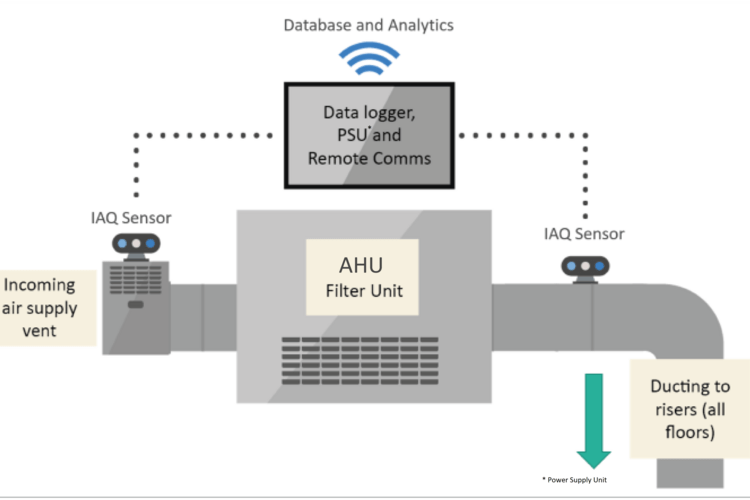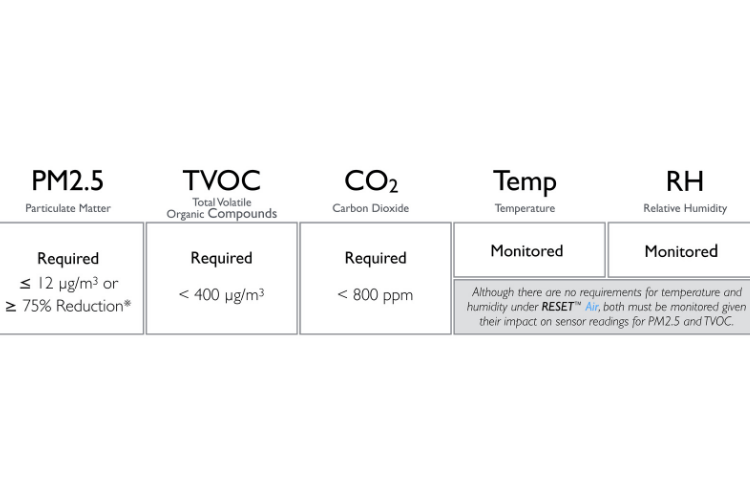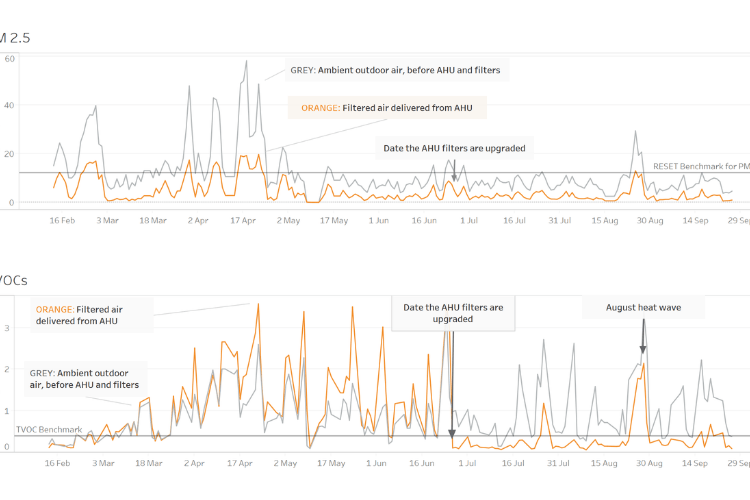Savills Proves the Power of Technology to Improve Air Quality in Existing Buildings
06 February 2020Savills Proves the Power of Technology to Improve Air Quality in Existing Buildings
06 February 2020In 2019, Savills piloted an evidence-based approach to improving indoor air quality in central London offices. The team aligned their approach with RESET™ Air – Core and Shell, a globally recognised standard. They installed RESET-accredited sensors in a multi-occupied building on a busy road and monitored performance against RESET targets. This yielded useful insights into air quality and empowered the building team to take action to improve performance.
Key Facts
- Measurably improved air quality for people in the building
- Insights into air quality challenges to inform teams in other buildings
- Exploring potential of sensors and RESETTM Air for stakeholders
Situation
Global real estate services provider Savills aims to provide clients with best-in-class services across the sustainability spectrum. In 2019, they chose a multi-occupied office building on Bishopsgate in central London to trial an indoor air quality monitoring programme based on RESET™ Air – Core and Shell. This is a globally recognised standard for monitoring indoor air quality, which includes performance targets.
Drivers for the project included:
- Health and wellbeing increasingly becoming areas of focus for property owners, occupiers and building teams.
- Air quality as an important aspect of wellbeing, and one that property owners and building teams can influence.
- New technologies and standards enabling opportunities to monitor and improve building performance.
Actions
Savills’ Sustainability and Technical Services teams worked with consultants Carbon Intelligence to install and monitor four sensors in the building.
To measure the quality of outdoor air prior to filtration, one sensor was fitted before the building’s single air handling unit (AHU). To measure the quality of air after filtration and as it travels through the building, another sensor was installed after the building’s AHU and two were installed in the ducting.
All four sensors are commercial grade and RESET-accredited for their sensor quality, performance and accuracy.
Sensor data was monitored against RESET indoor air quality performance targets:
The sensors revealed that the ambient outdoor air contained relatively high levels of particulate matter and total volatile organic compounds (TVOCs). These were associated with local vehicle traffic emissions and construction activity, with nearby road resurfacing works and a large development in the vicinity thought to be having a significant impact on ambient air quality.
In response, Savills engaged filter supplier Camfil to upgrade the AHU filters to broad-spectrum, carbon-activated filters, with additional High-Efficiency Particulate Air (HEPA) filter bags to capture very small particulate. These new filters reduced levels of particulate matter (PM2.5) to within the RESET performance target, improving air quality for people in the building.
TVOC concentrations were also significantly reduced, with a few spikes that Savills is investigating further. Building performance was also affected by environmental conditions; for example, there was a substantial increase in TVOCs in the outdoor ambient air during a heatwave in late August 2019. To gain insights into what was happening within this ‘basket’ of TVOCs, Savills instructed Camfil to fit a tester dish to capture the air and send it to a laboratory for analysis to identify the individual chemicals. This revealed that the VOCs present were not considered toxic to human health. Savills is continuing to investigate the specific composition of the VOCs and exploring potential management strategies. The team is also consulting with RESET on how additional knowledge around individual chemicals could influence the calibration of sensors to detect and monitor TVOC levels. Savills and the property owner are also evaluating the option of full RESET certification.
Financial
Approximately £15,000 for the entire project, including hardware, implementation and professional consultancy services.
Benefits
As the graphs below show, air quality has measurably improved since the project began, with PM2.5 within the RESET performance target and TVOCs substantially reduced. Savills is continuing to investigate additional potential improvement opportunities for TVOCs. CO2 levels were consistently within the RESET performance thresholds and so additional action was not needed.
Stakeholder benefits of air quality monitoring include:
For building teams: enabling a more proactive, evidence-based approach to optimising building performance, gaining insights into specific air quality issues in each building to identify improvement opportunities. Real-time data also enables a faster response, as building teams are alerted to issues as they arise, rather than through standardised annual maintenance schedules.
For occupiers: improving air quality, which can contribute to employee wellbeing, leading to fewer sick days and higher productivity.
For owners: enhancing building performance, which over the long-term can help attract occupiers, maintain asset value and reduce potential risks associated with underperforming buildings.
Challenges and Achievements
FILTRATION
How to improve air quality through filtration?
Savills manages all buildings for air quality and changes filters in line with all required standards. This pilot project has highlighted that standard filtration installed in typical air handling equipment does not always provide best practice filtration for polluted outdoor air. Filtration for air handling equipment should therefore be influenced by local air quality, as well as industry standards. For instance, in densely populated urban environments such as central London, emissions from traffic and construction activity can substantially elevate levels of TVOCs and particulate matter, and more effective filters may be needed. Weather patterns can also affect ambient outdoor air quality and introduce new VOCs that filters may be less able to cope with. Additional testing to identify individual chemicals can inform improvement strategies. Tailored filtration can significantly improve air quality in buildings.
OCCUPIERS
When to engage with occupiers on air quality?
Air quality is an important and sensitive issue. Many property owners and building teams want to have a good understanding of air quality in a building before engaging with occupiers. However, to gain insights into air quality throughout a building and improve performance, it may be necessary to engage with occupiers, as their spaces are often major sources of VOCs. These sources can include cleaning products, perfumes and air fresheners, as well as fit-out materials, such as paint, glue, furnishing and carpets. As building teams gain insights into sources of TVOCs within a building and into individual chemicals present, they are better equipped to engage with occupiers. It is important that property owners and building teams take a lead on this. As air quality sensors become more widely available, standards such as RESET are likely to become increasingly important in ensuring that building teams and occupiers are basing decisions on consistent, high-quality data from well-calibrated sensors.
*Please note that the information on this page was supplied by the BBP Member and the BBP assumes no responsibility or liability for any errors or omissions in the content



